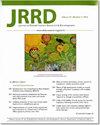Chronic Effects of Exposure to High-Intensity Blasts: Results of Tests of Central Auditory Processing
Q Medicine
Journal of Rehabilitation Research and Development
Pub Date : 2016-06-01
DOI:10.1682/JRRD.2014.12.0313
引用次数: 22
Abstract
Clinical Trial Registration: ClinicalTrials.gov: "Central auditory processing deficits associated with blast exposure"; NCT01567020; https://clinicaltrials.gov/ct2/show/NCT01567020 INTRODUCTION For well over a decade, the U.S. military has been engaged in conflicts that have changed the nature of injury and survival among Veterans because of changes in weaponry, battle armor, and medical technology that have taken place over the course of the past 20 yr [1]. According to the Institute of Medicine (IOM), these changes have resulted in a ratio of wounded to dead soldiers of 9.7 to 1 for the Global War on Terror, in contrast to rates of 4.3 to 1 or lower for all wars preceding it in the history of the United States [1]. Both the increased reliance upon explosives and the higher survival rate have created a landscape of new questions that must be answered in order to provide the best medical care for Veterans. This is true for hearing healthcare as much as for any other area of medicine. In 2014, the IOM issued a report on the chronic effects of exposure to high-intensity blasts [1]. In a systematic review of the literature, the IOM report found that symptoms of hearing loss are often present following blast exposure [2-3]. The report went on to state that while peripheral auditory dysfunction is likely to persist even after other effects have diminished, there was "inadequate" evidence in the literature to answer the question of whether or not central auditory effects persist beyond a period of 6 mo after blast exposure. The current report was motivated by ongoing research in our laboratory that has revealed evidence of an association between remote high-intensity blast exposure and the ability to process auditory information. Previous reports have described the ways in which blast exposure could [4] and does [3] cause changes in the ability of listeners to perform on tests of central auditory processing measured within a year of blast exposure. Tasks upon which blast-exposed participants were most likely to perform poorly included those relying upon temporal pattern perception, auditory temporal resolution, binaural processing, and dichotic listening. In addition, it has been demonstrated [3] that these problems occur even when traditional audiometric test results and electrophysiological measures primarily assessing the auditory brainstem remain largely in the normal range. Furthermore, electrophysiological measures evaluating cortical function indicate that some of these same listeners show delayed and reduced peak amplitudes relative to the responses expected from young listeners with normal peripheral auditory function. This pattern is consistent with the hypothesis that blast exposure can cause damage to cortical areas responsible for auditory processing, as well as potentially damaging the connections among central auditory processing areas. Clinically, these patterns of dysfunction are unusual in younger listeners but have similarities with patterns of abnormal performance sometimes observed in older listeners. Data collection and recruitment are currently ongoing, but this report has been compiled in order to provide timely information to the healthcare community regarding the question posed by the IOM concerning the possible persistence of the effects of blast exposure on the ability to process auditory information. To address this question, the behavioral data collected so far will be presented in a manner allowing direct comparison to the behavioral data from the previous study [3] of more recently blast-exposed patients. Additional measures not reported here, including a range of electrophysiological tests and a number of behavioral tests with speech and nonspeech stimuli, will be reported separately once the full cohort of participants has been recruited and tested. METHODS Participants The goal of the study was to test blast-exposed Veterans, but no database of such Veterans exists and the military records that might help to identify these Veterans are not available through the Department of Veterans Affairs (VA) electronic medical record system. …暴露于高强度爆炸的慢性影响:中央听觉处理测试的结果
临床试验注册:ClinicalTrials.gov:“与爆炸暴露相关的中枢听觉处理缺陷”;NCT01567020;https://clinicaltrials.gov/ct2/show/NCT01567020引言在过去的20年里,由于武器装备、战斗装甲和医疗技术的变化,美国军队已经参与了十多年的冲突,这些冲突改变了退伍军人受伤和生存的性质。根据医学研究所(IOM)的数据,这些变化导致全球反恐战争中受伤和死亡士兵的比例为9.7比1,而在此之前美国历史上的所有战争中,这一比例为4.3比1或更低。对炸药依赖的增加和存活率的提高都产生了一系列必须解决的新问题,以便为退伍军人提供最好的医疗服务。听力保健和其他医学领域一样,都是如此。2014年,国际医学研究所发布了一份关于暴露于高强度爆炸的慢性影响的报告。在对文献的系统回顾中,IOM的报告发现,爆炸暴露后经常出现听力损失的症状[2-3]。该报告继续指出,虽然周围听觉功能障碍可能在其他影响减弱后仍然存在,但文献中没有“充分”证据来回答中枢听觉影响是否在爆炸暴露后6个月后持续存在的问题。目前的报告是由我们实验室正在进行的研究激发的,该研究揭示了远程高强度爆炸暴露与处理听觉信息的能力之间存在关联的证据。以前的报告描述了爆炸暴露可能[3]的方式,以及[3]是否会导致听者在爆炸暴露一年内进行中央听觉处理测试的能力发生变化。暴露于爆炸的参与者最有可能表现不佳的任务包括那些依赖于时间模式感知、听觉时间分辨率、双耳处理和二元听力的任务。此外,已经证明,即使传统的听力测试结果和主要评估听觉脑干的电生理测量在很大程度上保持在正常范围内,这些问题也会发生。此外,评估皮层功能的电生理测量表明,相对于外围听觉功能正常的年轻听者的预期反应,这些听者中的一些人表现出延迟和减少的峰值幅度。这种模式与爆炸暴露可能导致负责听觉处理的皮层区域受损的假设是一致的,同时也可能破坏中央听觉处理区域之间的联系。临床上,这些功能障碍模式在年轻听众中并不常见,但与老年听众中有时观察到的异常表现模式相似。目前正在收集和收集数据,但编写本报告是为了及时向卫生保健界提供有关国际移民组织提出的关于爆炸暴露对听觉信息处理能力的影响可能持续存在的问题的信息。为了解决这个问题,迄今为止收集的行为数据将以一种允许与先前研究[3]中最近暴露于爆炸的患者的行为数据进行直接比较的方式呈现。其他未在此报告的措施,包括一系列电生理测试和一些言语和非言语刺激的行为测试,将在招募和测试完所有参与者后单独报告。研究的目的是测试爆炸暴露的退伍军人,但没有这样的退伍军人数据库存在,可能有助于识别这些退伍军人的军事记录无法通过退伍军人事务部(VA)的电子医疗记录系统获得。…
本文章由计算机程序翻译,如有差异,请以英文原文为准。
求助全文
约1分钟内获得全文
求助全文

 求助内容:
求助内容: 应助结果提醒方式:
应助结果提醒方式:


